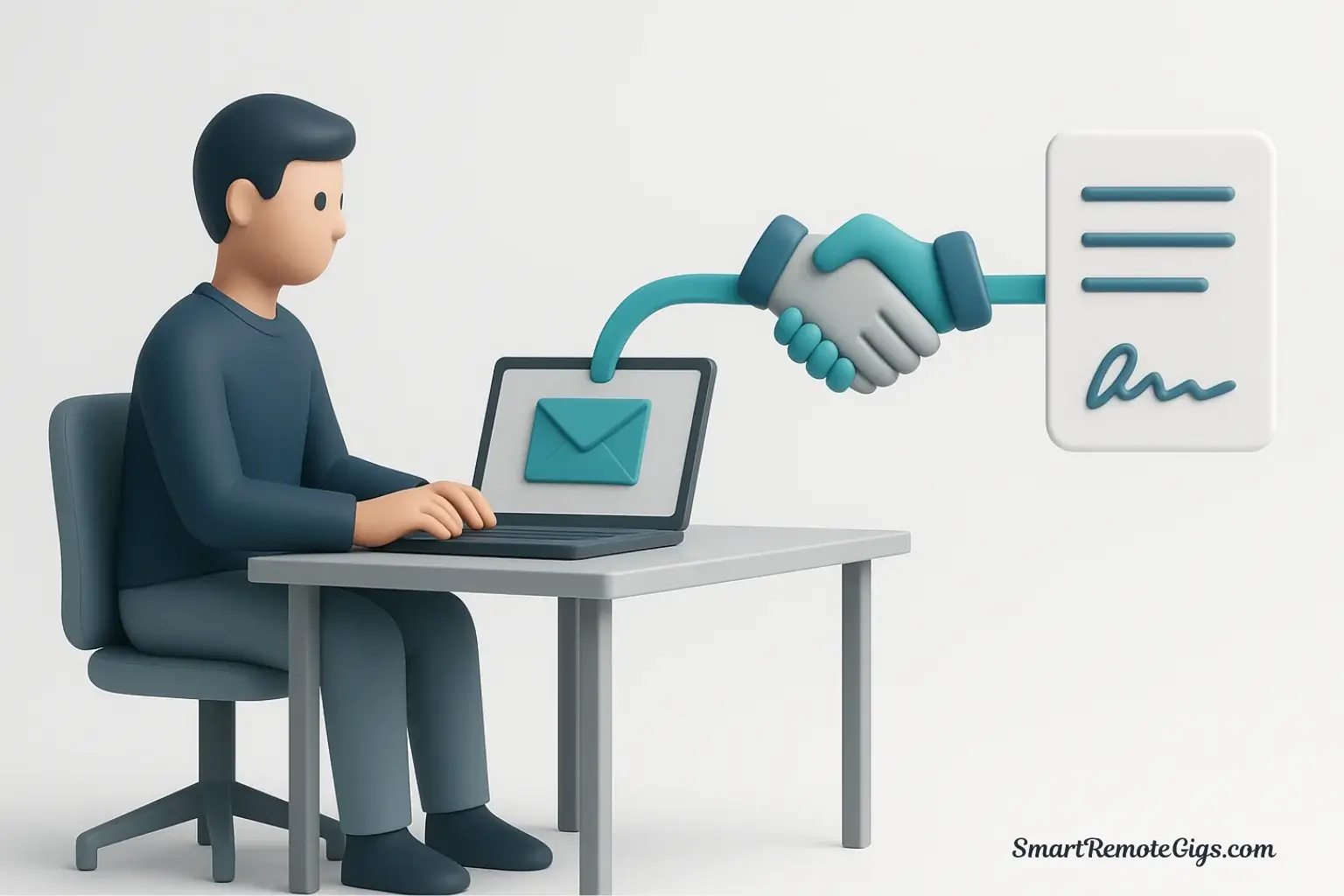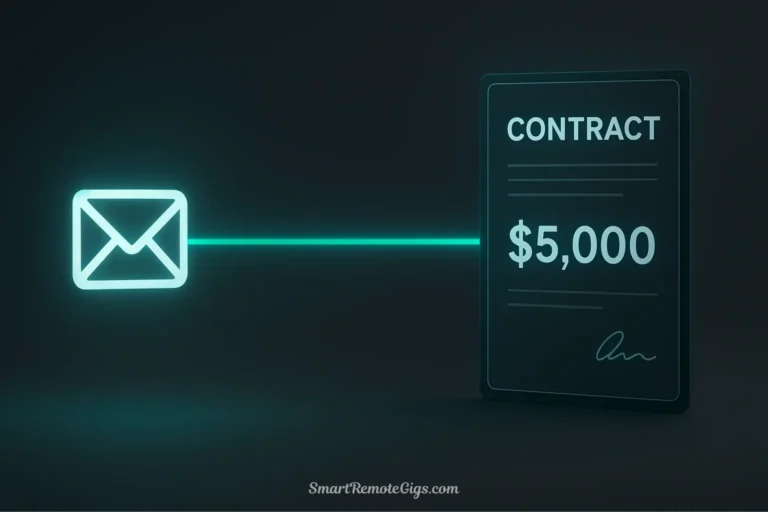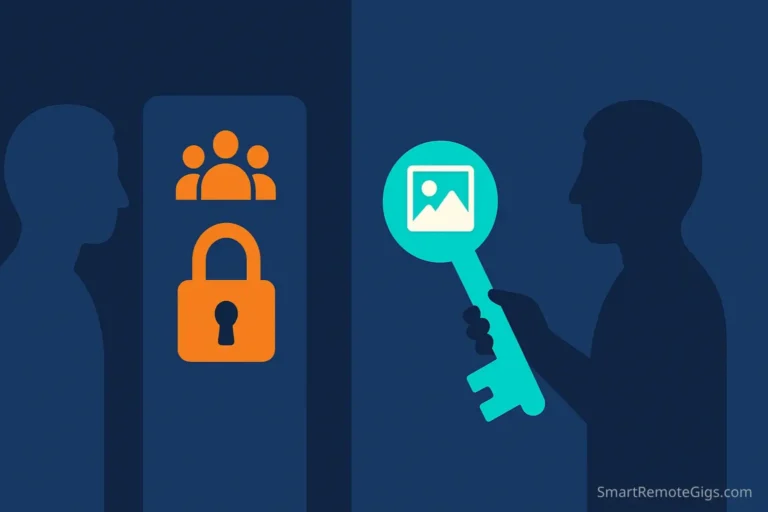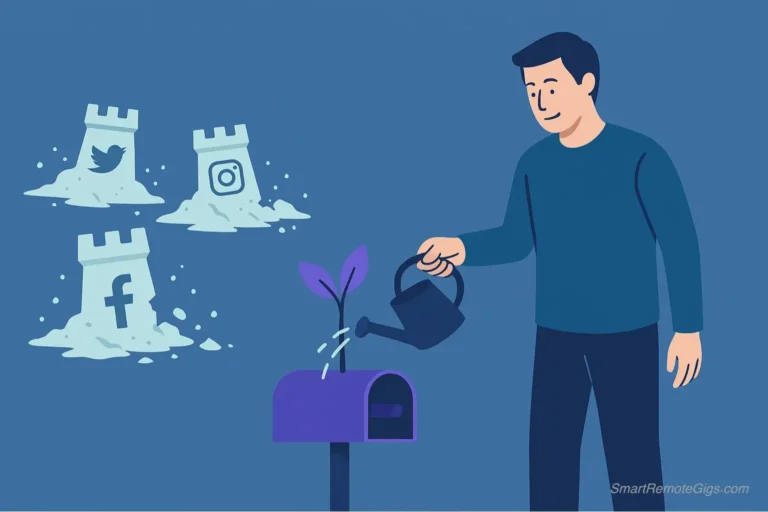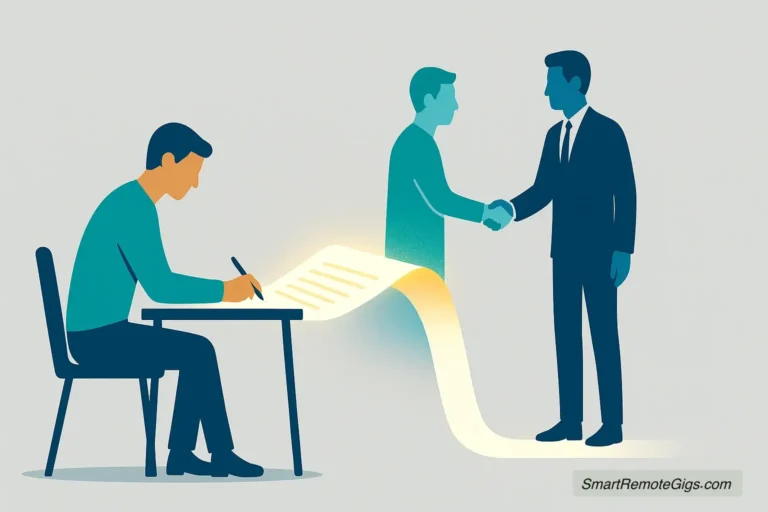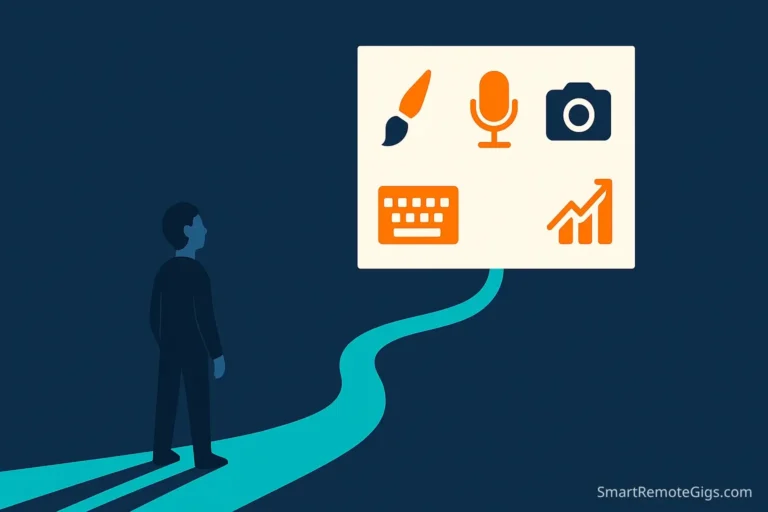Tired of the feast-or-famine cycle? Sending perfectly crafted portfolios into the void, only to hear crickets? You’re not alone. Most freelancers struggle with client acquisition because they’re waiting to be discovered instead of taking control of their pipeline.
Here’s the truth: freelance cold emailing isn’t about luck—it’s about having a system. This guide provides exactly that: a repeatable, proven framework that transforms cold outreach from a desperate shot in the dark into your most reliable source of high-quality clients. Based on real campaigns that have generated six-figure freelance businesses, this system works whether you’re a writer, designer, developer, or consultant.
Inside this guide, you’ll discover:
- The 3 Foundational Pillars you must have before writing a single email
- Our 5-Step System for crafting outreach that gets replies
- Proven Templates and Tools to get you started immediately
You’ll learn how to identify ideal prospects, craft personalized messages that stand out, and follow up professionally without feeling pushy. By the end, you’ll have everything you need to launch your first campaign today.
The Foundation: 3 Things You MUST Do Before Sending a Single Email
Most freelancers fail at cold email before they even hit send. They skip the strategic groundwork and jump straight to templates, wondering why nobody responds. The difference between a 2% reply rate and a 20% reply rate starts here.
1. Define Your High-Value Offer (Hint: It’s Not Just “Writing” or “Design”)
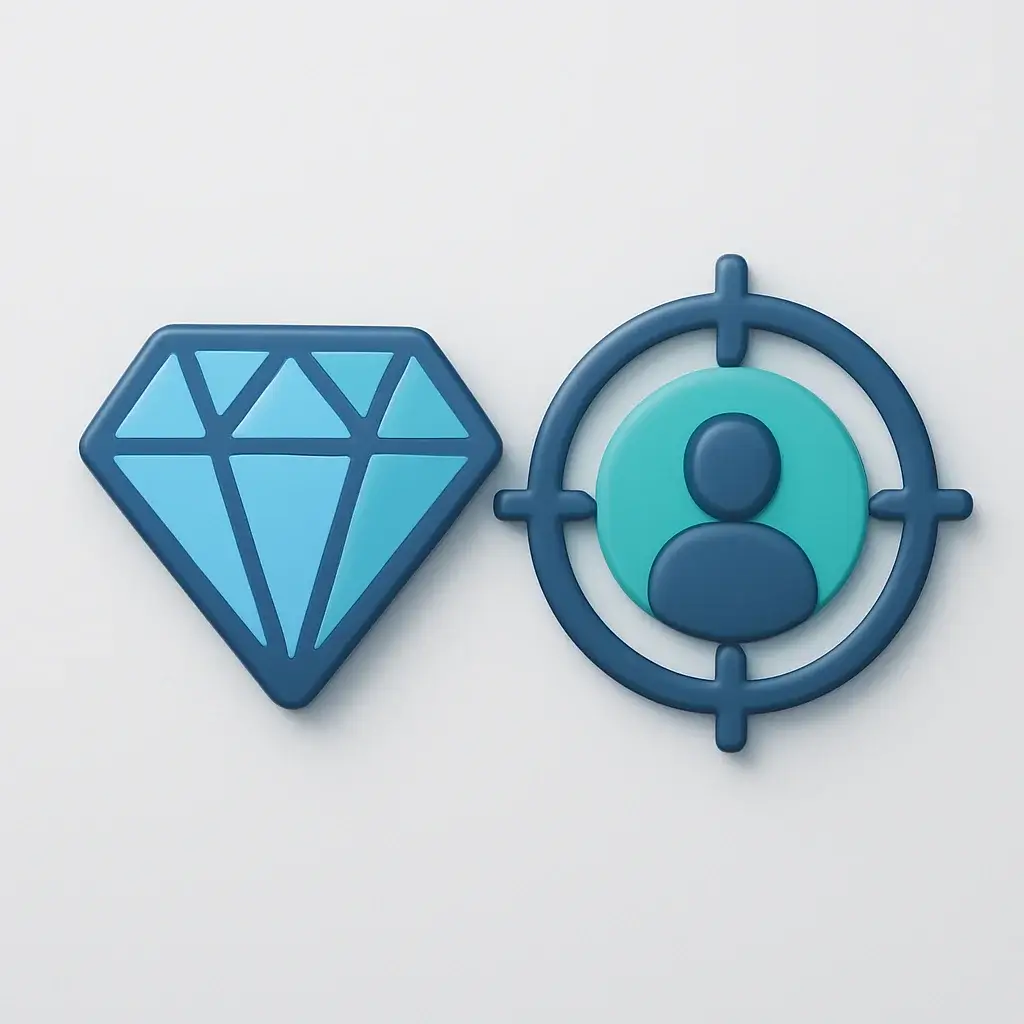
Saying “I’m a freelance writer” is like walking into a hospital and announcing “I’m a doctor.” Which kind? What problems do you solve? Your cold email for freelance client acquisition needs to answer one question immediately: What specific outcome do you deliver?
Instead of “I write blog posts,” try “I help SaaS companies turn technical features into content that converts trial users into paid customers.” Instead of “I’m a web designer,” position yourself as “I design high-converting landing pages for course creators that boost email signups by 40%+.”
This specificity does two things: it makes you memorable, and it helps prospects immediately understand if they need you. The more precisely you define the transformation you provide, the easier your cold outreach strategy for freelancers becomes.
2. Identify Your Ideal Client Profile (ICP): Who Are You Helping?
Your ICP isn’t just “small businesses” or “startups.” You need to know your ideal client so well that you could spot them at a conference. Consider these dimensions:
Industry or niche: Are you targeting e-commerce brands, B2B SaaS companies, real estate agencies, or health and wellness coaches? Pick one to start.
Company size: Solopreneurs have different needs and budgets than 50-person teams. A company making $500K annually operates differently than one making $5M.
Current pain point: What keeps them up at night? Are they struggling to generate leads, manage a growing customer base, or launch a new product? Your cold email best practices begin with understanding the problem you’re solving.
The tighter your ICP, the easier it becomes to build your prospect list and personalize your outreach. You’ll speak their language because you understand their world.
3. Create a “Minimum Viable Portfolio” to Showcase Your Value
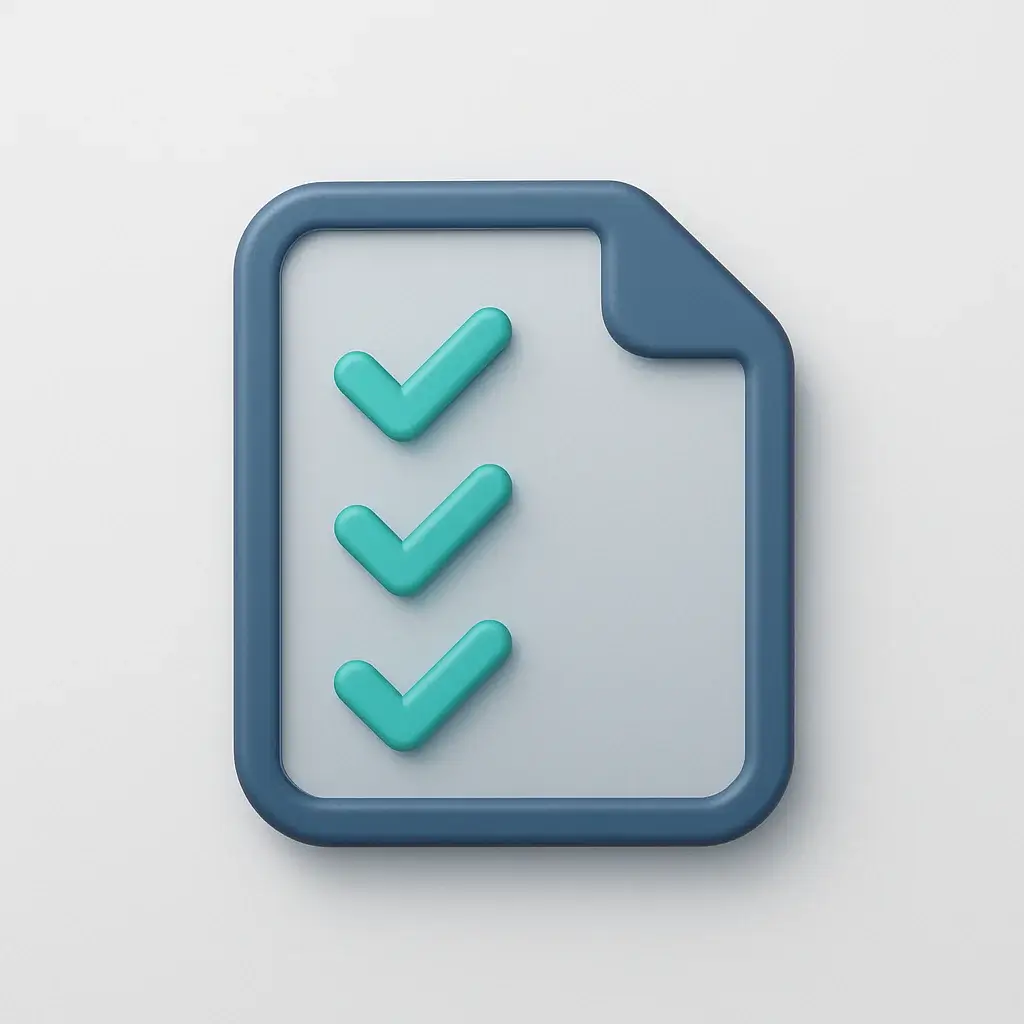
You don’t need 50 case studies to start cold emailing. You need 2-3 strong examples that demonstrate your ability to deliver results. If you’re just starting out, create spec work for your ideal clients, offer a deeply discounted “portfolio-building rate” to one ideal company, or showcase relevant work from other contexts (even personal projects).
What matters most is that each portfolio piece tells a story: Here’s the challenge, here’s what I created, and here’s the measurable outcome. Even if you can’t share revenue numbers, showcase engagement metrics, completion rates, user feedback, or your strategic process.
Your portfolio doesn’t live in a PDF—it lives on a simple one-page website or a Notion page. Make it easy for prospects to see your work in 60 seconds or less.
The 5-Step System for Winning Clients with Cold Email
This is where strategy becomes action. Follow these five steps in order, and you’ll build a cold outreach machine that generates consistent client opportunities.
Step 1: Building a Hyper-Targeted Prospect List
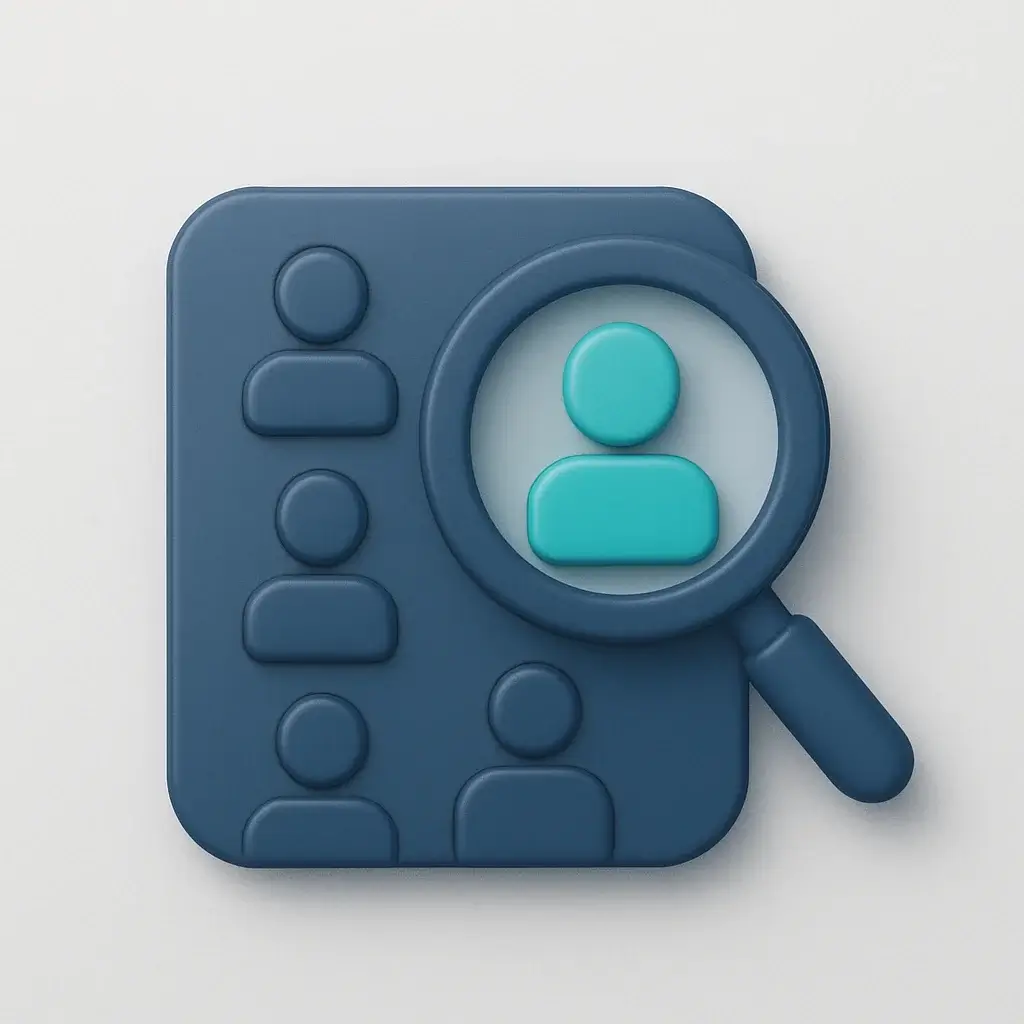
Before you write a single word, you need to know exactly who you’re emailing. Quality trumps quantity every time. A list of 50 perfectly matched prospects will outperform a scraped list of 5,000 random contacts.
Start by identifying companies that match your ICP. Use LinkedIn to find businesses in your target industry, browse industry-specific directories, or search for companies that just announced funding rounds or new product launches. These trigger events often signal a need for freelance support.
Once you’ve identified companies, you need the right contact. For most freelancers, this means finding the person who owns the problem you solve—typically a marketing director, head of content, product manager, or founder at smaller companies. Avoid generic info@ addresses.
For a comprehensive breakdown of the exact methods and tools professionals use to build these lists efficiently, see our guide on How to Find Email Addresses for Potential Clients.
Step 2: The Anatomy of an Email That Gets Replies
Every effective cold email follows the same basic structure. It’s not magic—it’s psychology and respect for the recipient’s time.
Personalized opening line: Start with one sentence that proves this isn’t a mass email. Reference their recent podcast appearance, a blog post they published, a company milestone, or something specific about their business. This is your “pattern interrupt” that earns you 10 more seconds of attention.
Concise value proposition: In 2-3 sentences maximum, explain who you are, what you do, and why that matters to them specifically. Focus on outcomes, not credentials. “I help companies like yours increase blog traffic by 50% in 90 days through strategic SEO content” beats “I’m an experienced writer with 10 years in the industry.”
Soft, low-friction call-to-action: Never ask for a 30-minute call in your first email. Instead, ask a simple question (“Are you currently looking for help with X?”) or offer a specific next step (“Would a brief 10-minute conversation make sense?”). Make it absurdly easy to say yes.
Keep the entire email between 75-125 words. Busy people don’t read paragraphs from strangers. They scan for relevance and delete fast.
Step 3: Crafting Subject Lines That Demand to Be Opened
Your subject line has one job: get opened. It competes with 50+ other emails in their inbox, so it needs to stand out without sounding like spam.
Good examples:
- “Quick question about [their company name]’s content strategy”
- “Idea for improving [specific page/project]”
- “[Mutual connection] suggested I reach out”
Bad examples:
- “Freelance Services Available!” (Screams spam)
- “You need to see this” (Creates zero context)
- “RE: Following up” (Dishonest, implies an existing thread)
The best subject lines create curiosity while providing context. They feel personal, not promotional. Test variations to see what resonates with your specific audience, but always lean toward clarity over cleverness.
Step 4: The Art of Personalization (Without Spending Hours)
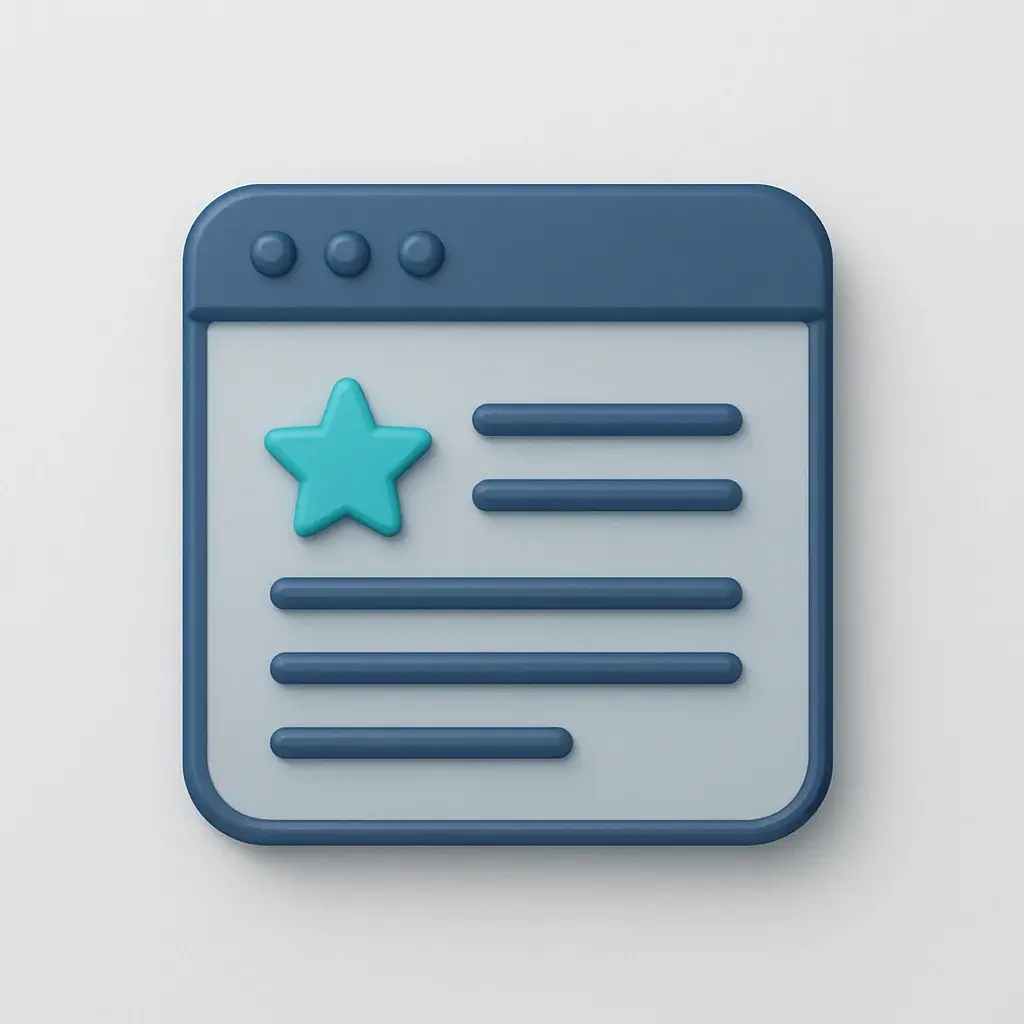
Here’s the secret to scaling cold email without sacrificing effectiveness: you don’t need to personalize everything, just one sentence.
That opening line we discussed? That’s where you spend your time. Find one genuinely interesting detail about their business, their content, or their recent activity. This takes 2-3 minutes per prospect if you’re focused.
The rest of your email can follow a template because your value proposition and offer remain consistent. This approach lets you send 10-15 highly personalized emails per day without burning out.
The “one genuine sentence” strategy works because it demonstrates real attention and effort where it matters most. Recipients can tell the difference between generic flattery (“I love your company!”) and specific observation (“I noticed your recent blog post about reducing churn had 200+ comments—clearly you’re hitting a nerve with your audience”).
Step 5: The Professional Follow-Up Sequence
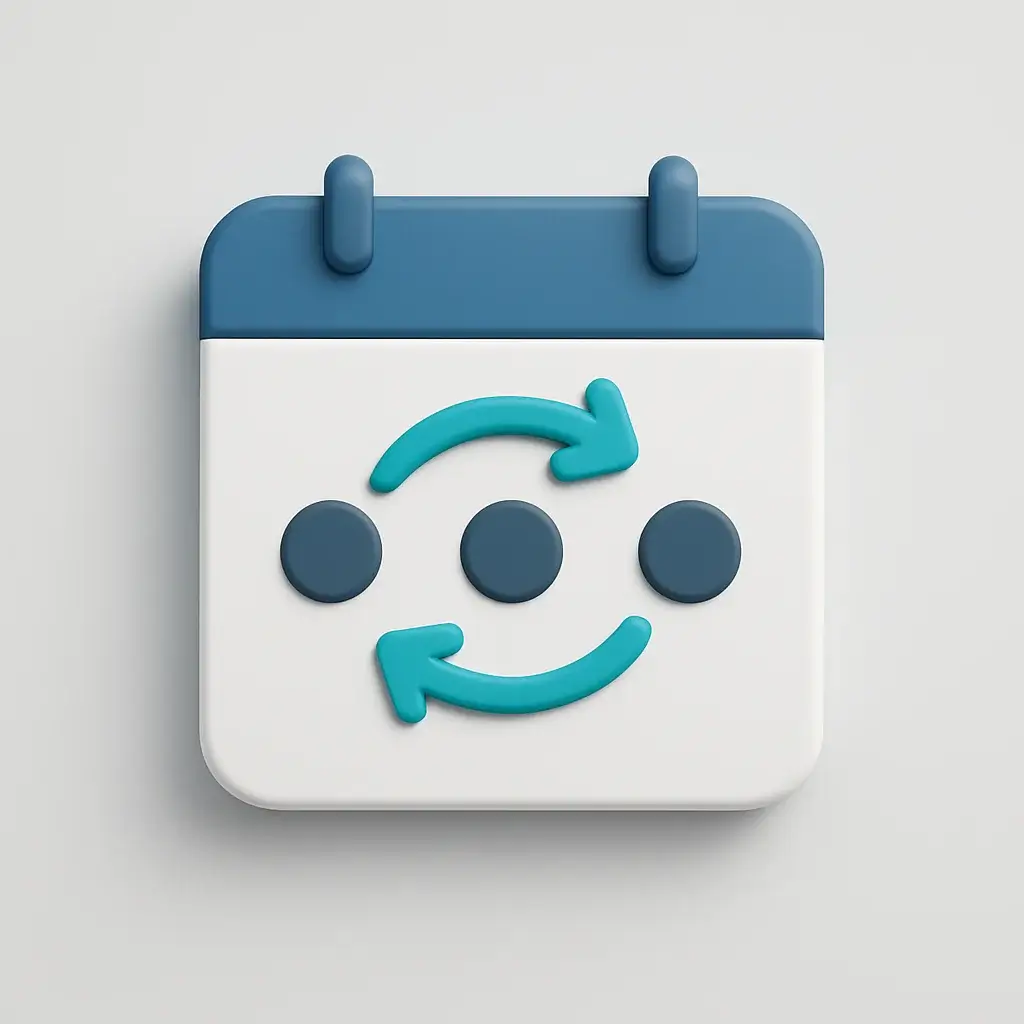
Here’s a statistic that should change how you approach cold email: most positive responses come from follow-up emails, not the initial message. People are busy. They miss emails. They mean to respond and forget. Following up isn’t pushy—it’s professional.
Use this simple sequence:
Day 0: Send your initial email in the morning (Tuesday-Thursday typically performs best).
Day 3: If no response, send a brief follow-up. Add new value if possible: “Following up on my email from Tuesday. I actually just saw [relevant news about their company]—this might be perfect timing to discuss [your service].” Keep it short.
Day 7: Final follow-up with a graceful exit. “I know you’re busy, so this is my last note. If timing isn’t right now, no worries at all—I’ll check back in a few months. Either way, wishing you success with [specific project/goal].”
This three-touch sequence respects their time while maximizing your chances of breaking through inbox noise. If they don’t respond after three emails, move on and revisit them in 3-6 months.
Your Starter Kit: A Proven Template & The Right Tools
Theory without action means nothing. Let’s give you the exact resources to launch your first campaign today.
One All-Purpose Cold Email Template to Get You Started
Subject: Quick question about [Company]’s [specific area]
Hi [First Name],
I noticed [specific, genuine observation about their company/content/recent news]—[relevant reaction or insight in one sentence].
I’m a [your role] who helps [your ICP] [specific outcome you deliver]. I’ve helped companies like [similar company] [specific result] and think I could do something similar for [their company].
Would it make sense to chat briefly about [specific project/challenge they likely face]? Happy to share a few ideas even if we don’t end up working together.
Thanks for your time,
[Your name]
This template works because it checks every box: personalization, clear value, and a low-pressure ask. Customize the bracketed sections, and you have a cold email that gets responses.
Need more variety? Whether you’re reaching out to different industries or testing different approaches, grab our full library of 5 Cold Email Templates That Get Replies.
The Freelancer’s Tech Stack: An Overview
You don’t need expensive software to start, but the right tools make scaling your outreach dramatically easier. Here’s what most successful freelancers use:
Email finders: Tools that help you locate valid email addresses for your prospects. Popular options include Hunter.io, Apollo.io, and FindThatLead.
Sending platforms: Services that let you schedule emails, track opens, and manage responses without using your personal Gmail. Look into GMass, Mailshake, or Lemlist for beginners.
CRM or spreadsheet: A simple system to track who you’ve contacted, when you followed up, and what responses you received. Start with a Google Sheet before investing in fancy software.
The key is starting simple. You can run your first 100-email campaign with nothing but Gmail and a spreadsheet. As you scale and see results, invest in tools that save time.
For detailed reviews of the specific platforms we recommend, including pricing breakdowns and feature comparisons, check out our guide to The Best Cold Email Outreach Tools for 2025.
Proof It Works: From a Single Email to a $5,000 Project
Still skeptical? Let’s look at a real example. A freelance content strategist targeting SaaS companies sent a cold email to a Series A startup struggling to convert blog readers into trial signups. The email took four minutes to write and included one personalized sentence about their recent product launch.
The founder responded within two hours. After a single 20-minute discovery call, the freelancer proposed a three-month content optimization project worth $5,000. No bidding war, no negotiation—just a direct path from cold email to signed contract because the outreach was targeted, valuable, and professional.
This isn’t an outlier. It’s what happens when you follow a proven system instead of throwing spaghetti at the wall. Want to see the exact email word-for-word and understand the strategy behind each sentence? Read our complete Freelance Cold Email Case Study here.
Frequently Asked Questions (FAQ)
Is cold emailing legal for freelancers?
Yes, cold emailing is legal in most countries, including the United States, as long as you follow specific guidelines. In the US, the CAN-SPAM Act requires that you include your physical address, provide a clear way to opt out of future emails, and honor unsubscribe requests within 10 days. You also cannot use misleading subject lines or fake sender information.
The key distinction: you’re offering professional services to businesses, not sending bulk promotional emails to consumers. As long as your emails are personalized, relevant, and sent to appropriate business contacts, you’re operating within legal boundaries. When in doubt, consult the FTC’s CAN-SPAM guidelines for complete details.
What’s a good open/reply rate to aim for?
For genuinely personalized cold email campaigns, aim for these benchmarks:
Open rate: 40-60% is solid for a targeted list with good subject lines. Anything above 60% suggests your targeting and subject lines are excellent.
Reply rate: 5-15% is realistic for cold outreach to new prospects. If you’re getting a 20%+ reply rate, you’ve nailed your targeting and message.
Positive reply rate: Of those replies, 30-50% should be genuinely interested (the rest will be “not interested” or asking to be removed). This translates to roughly 2-7 qualified conversations per 100 emails sent.
These numbers assume quality over quantity. Mass-blasted emails will show much lower engagement because they lack personalization and relevance.
How many emails should I send per day?
Quality always beats quantity. For maximum effectiveness, send 10-20 highly personalized cold emails per day when you’re starting out. This volume allows you to maintain the “one genuine sentence” standard of personalization while building a sustainable outreach habit.
As you refine your process and potentially use better tools, you might scale to 30-50 per day, but never sacrifice personalization for volume. Remember: one reply from a perfect-fit client is worth more than 100 emails to poorly matched prospects.
Also consider email deliverability. If you’re using a new email address, ramp up slowly to establish a good sender reputation. Sending 200 emails from a brand-new domain on day one is a fast track to the spam folder.
Take Action: Your First Campaign Starts Today
You now have everything you need to launch a successful freelance cold emailing campaign. Not someday—today.
Remember the system: Build your foundation by defining your offer and ideal client. Follow the 5-step process to create targeted, personalized emails that respect your prospect’s time. Follow up professionally because persistence separates successful freelancers from those still waiting for clients to magically appear.
Cold email isn’t about tricking people into responding. It’s about proactively connecting your valuable skills with businesses that need them. It’s about taking control of your client pipeline instead of hoping referrals and job boards will keep you afloat.
Your mission for today: Don’t just close this tab. Find five ideal prospects and draft your first email using the template above. Research each company for 3-4 minutes, write one genuinely personalized opening line, and hit send. Action is the only thing that matters.
The difference between freelancers who struggle and freelancers who thrive often comes down to one thing: they took the first step. Make that step today.
This guide provides a complete, step-by-step system for freelancers to find, contact, and land high-paying clients using professional cold email outreach. Follow these steps to build a reliable client acquisition pipeline.
Total Time: 5 hours
Define Your High-Value Offer & Ideal Client

First, clearly define the specific outcome you deliver, not just your service (e.g., “I help SaaS companies turn blog content into trial signups” instead of “I’m a writer”). Then, identify your Ideal Client Profile (ICP) by specifying their industry, company size, and the pain points you solve for them. This focus is critical for effective targeting.
Create a Minimum Viable Portfolio

Prepare 2-3 strong examples of your work that directly relate to the offer you defined in Step 1. Your portfolio should showcase measurable results or a clear strategic process. Host it on a simple, easily accessible webpage. You don’t need dozens of examples; you need proof you can solve the client’s specific problem.
Build a Hyper-Targeted Prospect List

Using your ICP, search on platforms like LinkedIn to find companies that are a perfect fit. Once you identify a company, find the specific decision-maker who owns the problem you solve (e.g., Head of Content, Marketing Director). Avoid generic ” info@ ” addresses. The quality of your prospect list is more important than its size.
Craft a Personalized Cold Email

Write a concise email (75-125 words) with the following structure:
1. Subject Line: Make it personal and curiosity-driven (e.g., “Quick question about [Company]’s content”).
2. Opening Line: Include one sentence of genuine, specific personalization based on your research.
3. Value Proposition: In 1-2 sentences, state the outcome you deliver for companies like theirs.
4. Call-to-Action: End with a low-friction question, like “Would a brief 15-minute call make sense to discuss a few ideas?”
Execute a Professional Follow-Up Sequence

If you don’t receive a reply, follow up professionally. Send your first follow-up email 3 days after the initial message, keeping it brief and adding new value if possible. Send a final, graceful exit email 7 days after the initial message if you still haven’t heard back. Most positive replies come from follow-ups.
Tools:
- LinkedIn Account
- Portfolio Page (e.g., personal website, Notion)
- Professional Email Account (e.g., Google Workspace)
- Tracking System (e.g., Google Sheets, Trello, free CRM)
